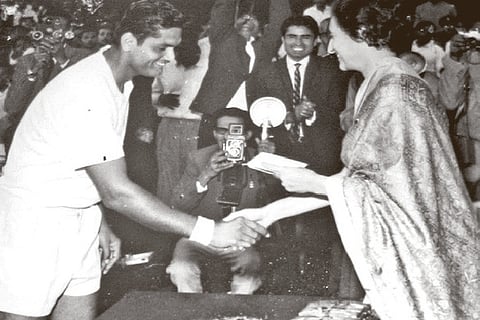

Chennai
THE year was 1951 and Professor Gordon, the principal of Loyola College, was disturbed by a determined appeal. To include a 13-year-old schoolboy from RKM School in the tennis tournament his college conducted annually exclusively for college students. The persistent village boy from Tenkasi had moved to Madras very recently and had started playing his tennis on cow dung plastered courts in the rural part of south Tamil Nadu.
Bertram Tournament, to perpetuate the memory of the Founder Principal of Loyola College, was an inter-college sports tournament and the tennis competitions were named after Stanley and Erskine, the Governors of Madras, and were facetiously termed the ‘Wimbledon of Madras’.
The underaged kid and his father somehow prevailed and luckily an empty slot appeared in the draws. And for the first time, a schoolboy participated in the competition for the best college-going tennis player in Madras. While many thought he was fodder for the first round, not only did Ramanathan Krishnan go on to thrash known seniors in the sport and claim the first prize, he didn’t lose a set for the whole tournament. Madras sat up to notice. A prodigy was on the prowl.
Loyola took the cue and schoolboys did play in the Bertram in the following decades, each of them making the country proud in the Grand Slams.
Tennis was first invented by bored European monks with hard balls and plain palms. But soon it found a way to charm civilisation. Just days before the Storming of the Bastille during the French Revolution, the prime movers of the rebellion gathered in a tennis court outside the Palace of Versailles and took the famous Tennis Court Oath. British officers brought tennis to India and just seven years after the Wimbledon tennis tournament started, there were tournament matches here. World War 2 was a godsend for the Indian game. When tennis faded in its European heartland, allied officers on war duty kept it alive and thriving in the subcontinent.
Though a Bertram champion, young Krishnan had very little space to practice tennis in Madras. Clubs did not allow people lesser than 18 to play and more so when he embarrassed very senior members on court. Krishnan was impatient and knew where he would be at the age of 18. Not at these Madras clubs for sure.
Krishnan stormed his way to become the junior national title holder in 1953. He would take a ship from Colombo (funded for the ticket by the sport-loving royal Vizianagaram family) to participate in the junior Wimbledon only to be soundly defeated in the first round. He came back and the father and son duo diligently did their homework to sail back the next year to return with the junior trophy.
Ramanathan Krishnan would become and stay India No. 1 for almost two decades. He is the only Indian to have reached the semi-finals at Wimbledon twice. Perhaps remain the Indian who came closest to the cup in history.
Krishnan is one main reason tennis got popular in India. There were not too many tournaments in India, but the so-called exhibition matches were held in cities, villages and even before jail inmates.
Ramanathan Krishnan led the three musketeers of Indian tennis — Jaideep Mukherjee and Premjit Lall being the other two — and at one point was the world number three. Krishnan could be termed unlucky that he faced the eventual trophy winner in the semi-finals or quarter-finals. But Ramanathan and co. made India a force to reckon with in tennis.
Tennis wasn’t a high paying game then but honour kept him going. Winning a match in London, Ramanathan would get back to his hotel room to be informed he had a telegram. It was an invitation for breakfast from the Prime Minister of India, Nehru, and his daughter Indira who was also in London that day.
But though Ramanathan must be remembered for his ‘touch tennis’ style in the days technology did little to help the player’s abilities, his decision to stay content in years where greed was the motivating force should be remembered as well.
Things changed for international tennis when Grand Slam champion Jack Kramer retired from competitive tennis in 1954 due to arthritis and went on to promote his Pro Tour. He started poaching amateur players with promises of hefty payments. Krishnan was offered 1,50,000 dollars for three years while he would have made less than 100 if he had won the Wimbledon.
Krishnan took the greatest decisions in his life, that of not succumbing to the money bags as he couldn’t play Wimbledon or Davis Cup for his country if he turned professional. After he retired at 32, Krishnan made a living selling LPG cylinders in Mandaveli.
— The writer is a historian and an author (Reference: Advantage India: The Story of Indian Tennis by Anindya Dutta)
Visit news.dtnext.in to explore our interactive epaper!
Download the DT Next app for more exciting features!
Click here for iOS
Click here for Android